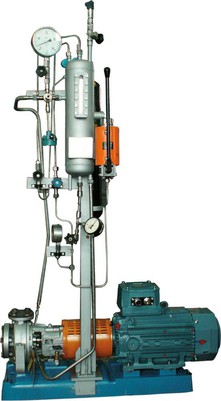Research and production Centre
Mechanical seal support system
- They are designed for cooling buffer/barrier liquid, for providing technological control over the operation of the mechanical seal, the formation of protection signals in case of failure of the seal.

- They are provide the operability of any double mechanical seals of the tandem type and the double ones, operating inside and outside, installed in 'hot' pumps (with the temperature of the pumping environment up to + 400 °С).
- The used materials, design and manufacturing technology allow the system to perform at the necessary operating pressure without requiring the installation of safety valve.
- The vessel of the mechanical seal (VTMS), being the part of the system, can be made as whole-welded or detachable, with a built-in coil or straight-tube heat exchanger.
- In order to reduce the welding works at the customer's area (welding nuts, nipples, adaptors) they use plug-in connectors.
- The system of instrumentation allows to monitor the operation of mechanical seals as visually as at distance, providing an automatic protection mode.
- Depending on the nature of deviations of the technological parameters of the system, light and sound alarms are provided with the operator's intervention in the control of the process and automatic control with the transition to the standby pump and the shutdown of the emergency pump.
- For the safe exploitation of the pumping aggregate there has been designed and implemented system of automatic control of technical parameters (SCTP-1) of the pumping aggregate.
The choice of buffer/barrier liquid for operation of mechanical seals
The correct choice of the buffer/barrier liquid is one of the most important factors, having impact on durability reliability of the operation of mechanical seals.
You need to take in consideration the following factors:
- Compatibility of buffer/barrier liquid with the pumping product;
- Compatibility of buffer/barrier liquid with the materials of the construction of the mechanical seal, the tank, the pipeline and the pump;
- Compatibility of buffer/barrier liquid with the gas in case when the circulation of the buffer/barrier liquid is performed under the gas pressure;
- Buffer/barrier liquid should be not toxic and have a minimum impact on the environment and humans;
- Viscosity of the buffer/barrier liquid in dependence on the conditions of exploitation and the climate;
- The boiling temperature of buffer/barrier liquid is recommended to be 10°С higher than working temperature,
- In the presence of oxygen the temperature of flashpoint have to be higher than buffer liquid temperature;
- It is inadmissible to form deposits, gels, emulsions, polymerization, crystallization or coking.
Locking of auxiliary systems
- For mechanical seals of type 'tandem' (configuration 2): at reaching the pressure in the tank for buffer liquid Рmax = 0,5 … 0,75 Рsuct. – warning sound and light alarm.
- For double mechanical seals (configuration 3): at reducing the pressure in the tank for barrier liquid less Рmin = Рsuct.+0,05 МPа – warning light and sound alarm.
- At reducing the level of buffer/barrier liquid less than minimum there is warning light and sound alarm. You need to turn the unit off during 3 minutes (go reserve).
- At increasing the temperature of buffer/barrier liquid at the outlet of the mechanical seal more than 100 °С – warning light and sound alarm.
- The conditions of the alarms and interlocks can be changed in each specific case depending on:
- the pressure at the pump suction,
- the temperature of pumping environment,
- the temperature of cooling environment.
Installation recommendations
- After fitting and welding the pipes, it's necessary to clean their inner surface. The ingress of foreign objects and dirt is contraindicated for normal operation of the mechanical seal.
- During the preparation of the system for supplying buffer/barrier liquid it's necessary to follow the rule, that the number of bends of the supply and discharge pipes must be minimal and not exceed 270 degrees. A large number of bends complicates the slows the circulation of the barrier liquid.
- At fulfilling the mechanical seal with buffer/barrier liquid recommended feed rate of barrier liquid into the vessel is not much than 1-2 l/min that provides the removal of air from the cavity of mechanical seals.
- At reaching the level of 30…100 mm lower than the branch pipe of the exit of the barrier liquid in the vessel, scroll the pump shaft manually 2-3 turns, that allows completely eliminate air from the cavities of the seal.
- After filling the tank the initial level of barrier liquid should reach normal level mark to will insure the continuous circulation of barrier liquid through the tank.
- For double mechanical seals UTD type gas pressure in the tank should be set not lower than of 0,1 MPа bigger, than the pressure in the stuffing box of the pump. If necessary carry out the correction of pressure till 0,3 МPа after starting the pump and heating the seal to the operation temperatures.
- The speed of gas dissipation in the tank is not regulated, however, in order to increase the safety of the operation it is recommended not to exceed speed 2…3 kgc/cm2 per second.
The reliable operation of mechanical seals depends on the correct choice of the type of mechanical seal, sealing materials, schemes of piping and qualifications and skills of the service staff.
Production

